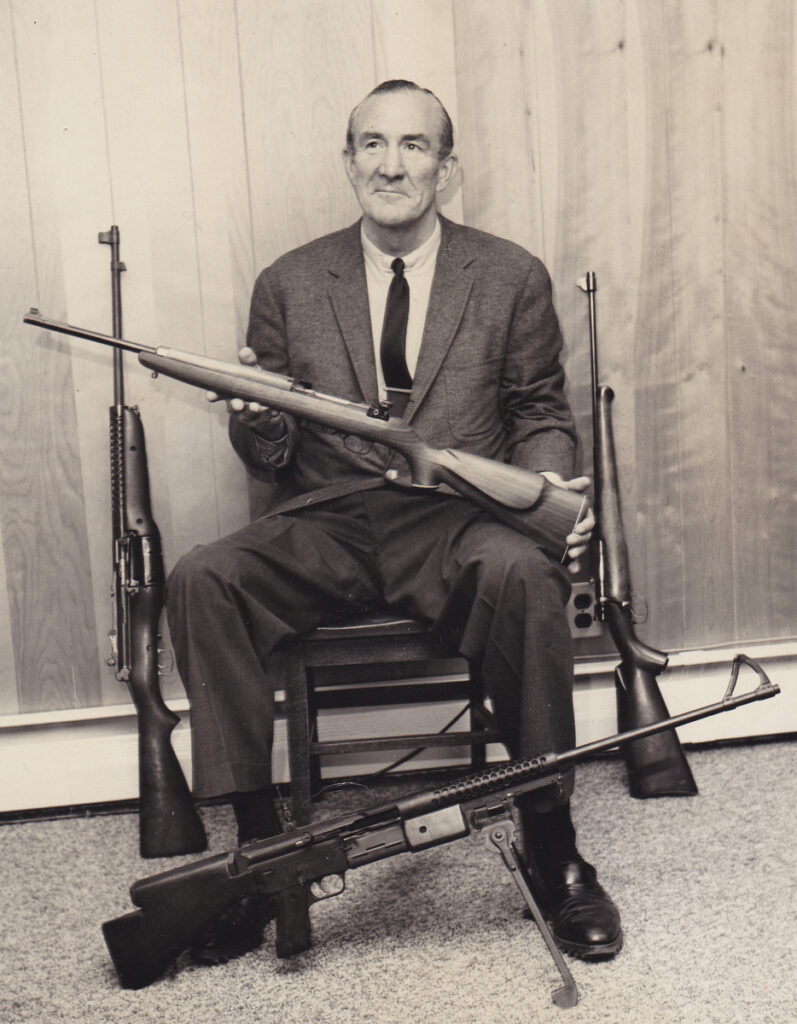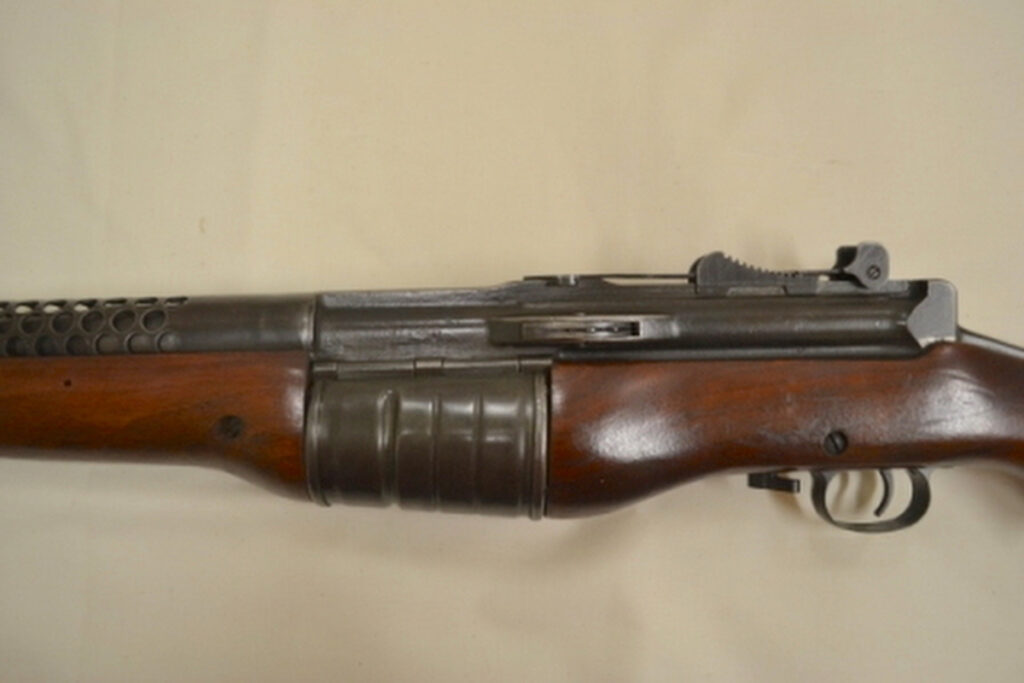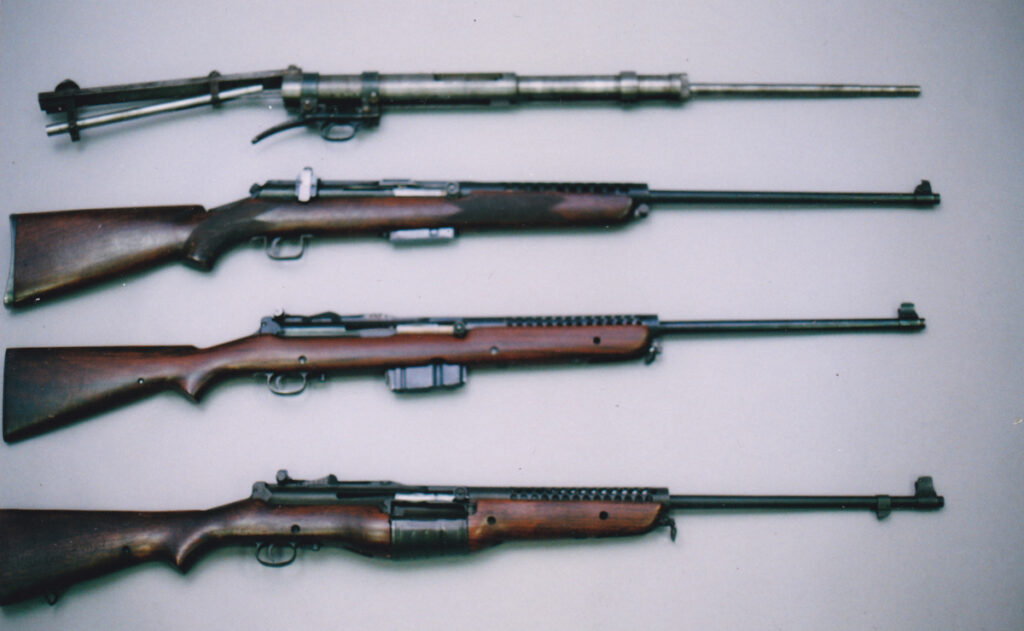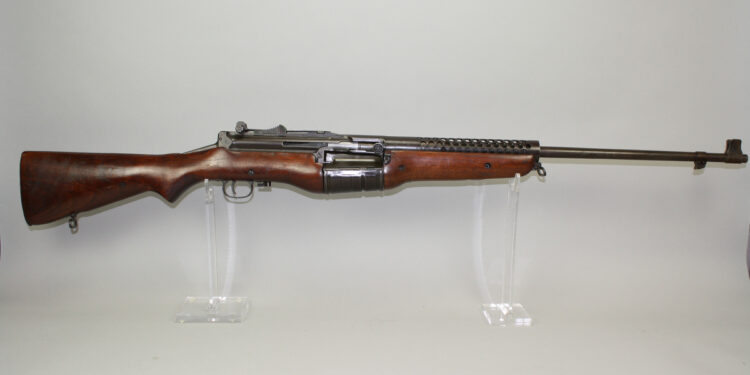By Jim Dickson
The title of the most reliable semi-auto rifle of all time goes to the M1941 Johnson. While the M1 Garand has been known to jam just from the sand the surf imparts in an amphibious landing, one of the favorite demonstrations of Melvin Johnson was to stuff a rag in the bore of his invention (so the barrel would not get obstructed and burst), then bury the gun completely in the sand and have it come out firing when it was dug up.

The Johnson possesses one of those rare mechanisms that throws sand and dirt out of the action instead of jamming on it. I have talked to Army Ordnance men who tested the M1941 Johnson and they said that it was the ONLY gun that they ever had that they could never make jam. At the time, this made the recently adopted M1 Garand look bad. The top brass in Army Ordnance decided to lie their way out of it. They attacked Melvin Johnson’s invention in every way possible. While the Johnson’s long action soaks up almost all recoil, the M1 Garand’s action does almost nothing to mitigate recoil and has the same recoil as a bolt action rifle of the same weight. The response of the Ordnance team was to make the ridiculous claim that the soft kicking Johnson kicked so hard that it would break the soldier’s shoulder! Well, my 5-foot 2-inch, 105-pound wife never had a problem with the minuscule recoil of the Johnson.

ROTARY MAGAZINE
The first Johnson rifles used a conventional box magazine. During a test, Melvin Johnson caught Ordnance loading the cartridges in backwards, thus ruining the magazine feed lips so that magazine failure was insured. Johnson demanded they use new magazines before the test began. Ordnance haughtily refused, and when the ruined magazines failed to work properly, they put it down as the gun jamming. This brazen and open sabotage was typical of their response to the Johnson.

It is not just the Johnson rifle that was treated this way. Ordnance has a long been suspected of not seriously considering any gun outside their own little clique, no matter how superior it may be. There may be another darker reason surrounding the hostility Ordnance was alleged to have had for the Johnson rifle, however. An Ordnance officer in a position to know told me that the top brass had misappropriated one million dollars for the development of the M1 Garand and this money could only be hidden in the M1’s production run. If the Johnson had been adopted, this would have all come out and these men would have gone to prison. At any rate, Johnson saw that no box magazine could escape sabotage in Ordnance tests, so he came up with his revolutionary 10-shot rotary magazine that could be topped off with standard 5-round stripper clips (or loose ammo) at any time during use. Men in combat loved it; as, if you were careful, you would never be caught reloading an empty gun with potentially fatal consequences in close quarters battle. In contrast, at the other extreme, the M1 Garand ejects it’s en bloc clip with an audible and distinctive “PING” letting everyone around you know when you have to reload. Ordnance hated that the Johnson rifle held two rounds more than the M1 so much that when the Johnson’s intended for the Dutch came into U.S. Service in WWII they blocked as many of the magazines as they could to eight rounds. My Johnson was blocked like this and had to have the magazine fixed to hold the full 10 rounds.

HANDLING AND ACCURACY
The handling qualities of the Johnson are like a fine British shotgun. When it first came out, men demonstrated this by killing birds on the wing with it. It’s handling qualities make instinct shooting easy. I have killed deer in mid leap with the M1941 Johnson where there was no possibility of using sights fast enough. Instinct shooting made perfect shoulder shots.
Accuracy is consistent, as there is no metal-on-wood for the barrel. It is all metal on metal and there is a ventilated handguard so that, no matter how much the barrel heats up during rapid-fire, you will not burn your hand. Too bad the old BAR wasn’t so carefully laid out. You really had to be careful around the BAR’s hot exposed barrel in combat. The worst M1941 Johnson will shoot a 2 MOA group and mine does 1 MOA. Your average M1 Garand does 3 MOA while the average M1 carbine does 2 MOA. That is assuming that the M1 rifle and M1 carbine have not had cleaning rod damage to the rifling at the muzzle since you can’t use the cleaning rod from the breech end.
QUICK CHANGE BARREL
The Johnson rifle has the quick release barrel of a machine gun, making cleaning a breeze. Simply use the nose of a cartridge to depress the barrel release at the tip of the forend and now you can withdraw the barrel. You can pour water down the bore at the breech-end directly from your canteen without worrying about getting water in the rest of the gun. Since the WWII corrosive primers contain salt, and according to the U.S. Bureau of Mines salt is ONLY soluble in water, this is important. Since the timing of the unlocking of the action is well after the bullet leaves the barrel, there is very little powder fowling in the action. This can be a lifesaver in the heat of intense, prolonged conflict where there is simply no time to clean your gun. I am always amazed at how little fouling is in the Johnson action after extensive shooting.
SHORT RECOIL ACTION
The Johnson utilizes a short recoil action. Like the German machine gun designers of the MG34 and MG42, Melvin Johnson realized that gas operated weapons were inherently self-jamming due to powder fouling and corrosion. I have seen a tiny bit of rust in an M1 rifle’s gas system lock the gun up so completely that even stomping the operating rod handle would not open the action. By using recoil operation, he eliminated these problems. Between the heavy barrel recoiling a ¼-inch before unlocking the bolt, the long bolt throw backed by a long spring in the buttstock, and the weight of the gun, recoil was negligible. Recovery time was sped by the fact that the stock was as straight as possible while retaining conventional sights. The result was greatly expanded rapid-fire capability. Melvin Johnson realized that effective full-auto fire requires a gun designed from the ground up as a light machine gun, as opposed to simply putting a selector on a light rifle or carbine. The rifleman would always score more hits per rounds fired with aimed rapid-fire and the Johnson excelled at this. Add to this it’s handling like a fine shotgun and you have a winning combination for combat where whoever sees and hits the enemy first wins the gunfight. You have to have been in that situation to fully appreciate how important this is.
The bolt of the M1941 Johnson has multiple locking lugs which allows both for a shorter movement to unlock and allows extra protection against locking lug cracks. Johnson remembered the U.S. Krag rifle which sometimes had cracks in the locking lugs, unlike the Norwegian Krag rifles. In later years some U.S. M1 carbines had this problem, as well.
The action is good for up to 75,000 PSI chamber pressure and the gun will continue to work reliably there. This is in sharp contrast to the M1 rifle which could not work for any length of time with the powerful 30-06 M1 ammunition adopted in WWI. They had to go back to the original 1906 load for the M1 rifle and they tried to cover this up by redesignating it “M2” ball ammo. When the war in the Pacific demanded the 30-06 AP (armor piercing) round to deal with the entrenched Japanese, there was a widespread call for its adoption and the replacement of the M2 ball ammo. The trouble was the M1 Garands were not holding up under the pounding of this more powerful round, so it was not adopted. When the M1 was replaced by the M14 (which was basically an M1 with the White gas system that Garand had rejected as less reliable when designing the M1 and a 20-round magazine) they went to the 7.62 NATO round which put even less stress on the gun. Today you can find 30-06 loads marked as “Safe for M1 Garands” because some of the more powerful sporting loads are tearing the M1 Garands up.

CHAMBERINGS
The Johnson prewar commercial guns often came with a .270 barrel, a 30-06 barrel, and a .35 Whelan barrel. The guns worked perfectly in all three calibers simply by changing the barrels. My personal M1941 has a 7mm Mauser barrel, the issue 30-06 barrel, and a 35 Whelan barrel. It shoots all calibers reliably, as well as all loads of these calibers. In addition to the Remington 35 Whelan loads, I also had Wolfgang Romey in Germany load me some 35 Whelan with bullets for the 350 Rigby and the 350 Rigby Magnum to Rigby velocities. We are talking about calibers from .270 to .35 and bullet weights from 140 grains to 310 grains. They all work just fine. Just swap out the quick-change barrels and you are good to go. Try all that with any other semi-auto ever made.
CONCLUSION
How does the Johnson stack up against today’s M4 carbine, AK74 and others? It offers accurate fire out to 1000 meters, faster, surer aimed rapid-fire, greater reliability, and more power and penetration. As previously noted, the 10-round rotary magazine can be continually topped off so that you never run out of ammo or get shot while trying to change a magazine. In short, the M1941 Johnson can be more effective than today’s assault rifles.












